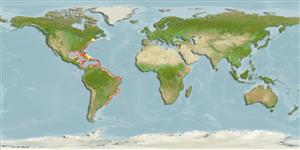Environment: milieu / climate zone / depth range / distribution range
Ecologia
marino batidemersale; distribuzione batimetrica 87 - 544 m (Ref. 37343), usually 300 - 500 m (Ref. 9626). Deep-water; 46°N - 37°S, 97°W - 32°W (Ref. 57286)
Western Atlantic: Canada (Ref. 5951) North Carolina, the Gulf of Mexico, Caribbean Sea to Uruguay (Ref. 47377) and Brazil (ISH specimens).
Size / Peso / Age
Maturity: Lm ? range ? - ? cm
Max length : 14.4 cm TL maschio/sesso non determinato; (Ref. 49695); common length : 10.1 cm SL maschio/sesso non determinato; (Ref. 13608)
Spine dorsali (totale) : 10; Raggi dorsali molli (totale) : 9; Spine anali: 2; Raggi anali molli: 7 - 8; Vertebre: 25. Anterior edges of pelvic spine, and 2nd spines of 1st dorsal and of anal fin serrated, but that of 2nd dorsal smooth (Ref. 13608).
Inhabits outer parts of the continental shelves and the upper parts of these slopes (Ref. 37343).
Life cycle and mating behavior
Maturità | Riproduzione | Deposizione | Uova | Fecundity | Larve
Schwarzhans, W.W. and A.M. Prokofiev, 2017. Reappraisal of Synagrops, Günther, 1887 with rehabilitation and revision of Parascombrops Alcock, 1889 including description of seven new species and two new genera (Perciformes: Acropomatidae). Zootaxa 4260(1):1-74. (Ref. 116586)
IUCN Red List Status (Ref. 130435: Version 2024-1)
Threat to humans
Harmless
Human uses
Strumenti
Special reports
Download XML
Fonti Internet
Estimates based on models
Preferred temperature (Ref.
123201): 8.6 - 16.9, mean 11.6 °C (based on 109 cells).
Phylogenetic diversity index (Ref.
82804): PD
50 = 0.5001 [Uniqueness, from 0.5 = low to 2.0 = high].
Bayesian length-weight: a=0.00871 (0.00518 - 0.01464), b=2.97 (2.82 - 3.12), in cm total length, based on LWR estimates for this species & (Sub)family-body (Ref.
93245).
Trophic level (Ref.
69278): 3.5 ±0.5 se; based on size and trophs of closest relatives
Resilienza (Ref.
120179): Medio, tempo minimo di raddoppiamento della popolazione 1.4 - 4.4 anni (Assuming tmax>3).
Fishing Vulnerability (Ref.
59153): Low vulnerability (10 of 100).
